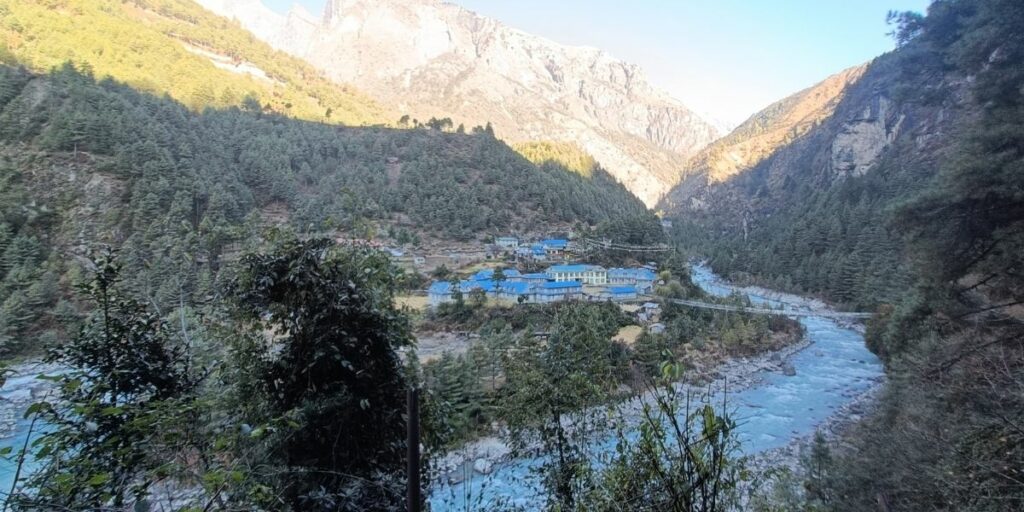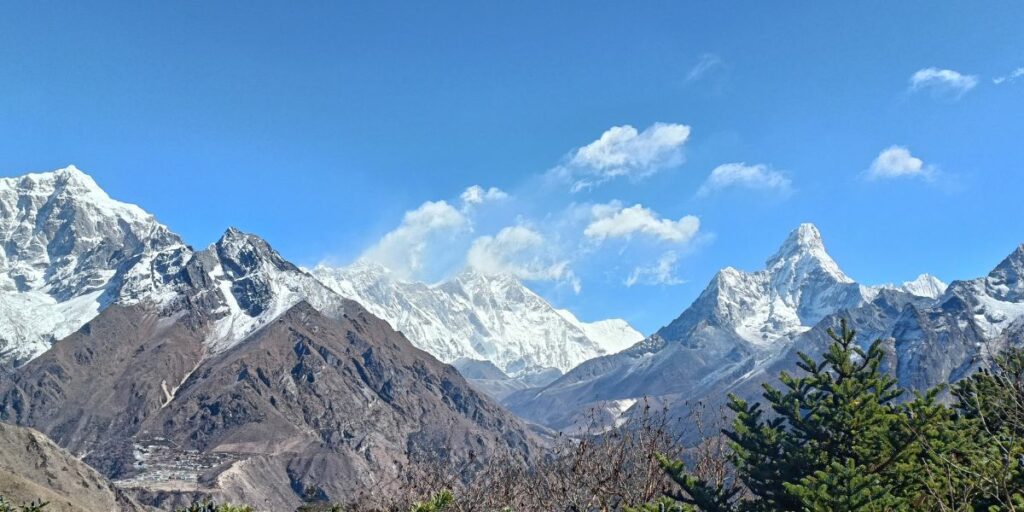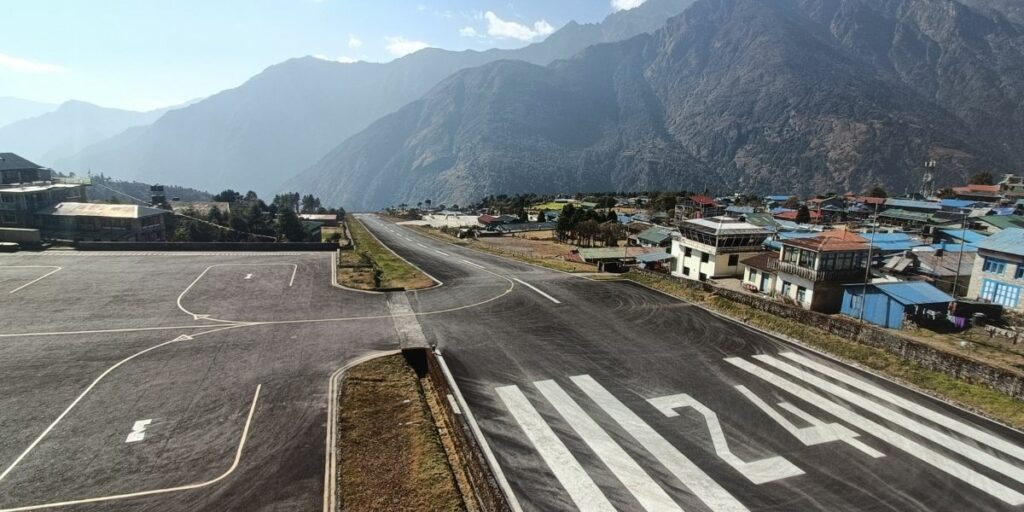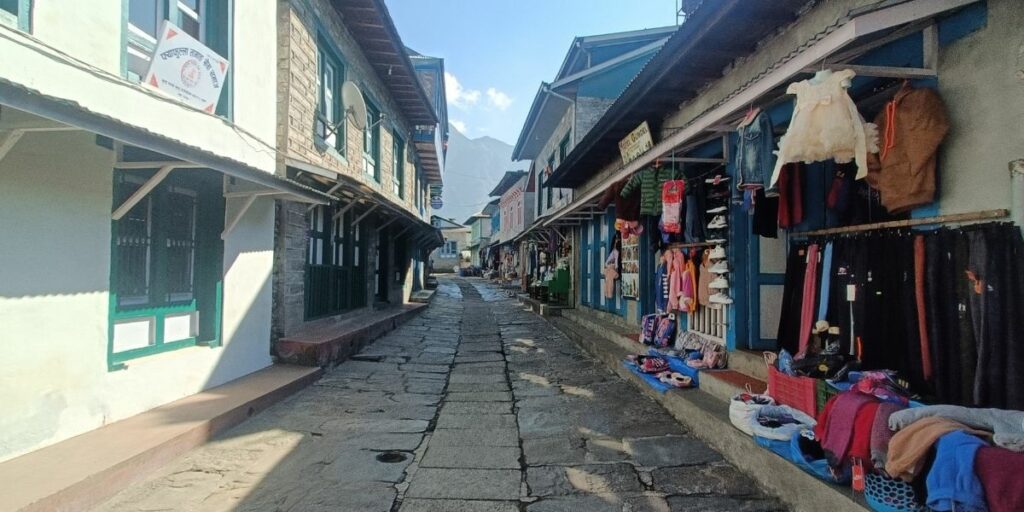All About Namche Bazaar: Facts, History, and How to Reach
Namche Bazaar stands as one of Nepal’s most remarkable mountain settlements. It is known worldwide as the “Gateway to Everest,”. Namche Bazaar is a busy Sherpa town and an important stop for acclimatization. For many trekkers and climbers heading to the world’s tallest mountain, its resting point. This unique mountain community combines ancient Sherpa traditions with modern adventure tourism. Originally, Namche Bazaar was a key trading post connecting Tibet with lower Nepal. Today, it is the commercial and cultural center of the Khumbu region. Visitors can experience an authentic glimpse of high-altitude Himalayan life here. To reach Namche Bazaar, you can fly from Kathmandu to Lukla. From Lukla, it takes about two days of trekking through beautiful Sherpa villages and over suspension bridges to arrive at Namche. This route offers stunning views and serves as an essential acclimatization journey.
What is Namche Bazaar and Where is it Located?
Namche Bazaar is a vibrant Sherpa town nestled in the heart of Nepal’s Khumbu region, at an altitude of approximately 3,440 meters (11,290 feet). Strategically located on a mountainside ridge, it lies along the main Everest Base Camp trekking route. It also serves as a vital stop for trekkers and climbers. Towering peaks and deep valleys surround it and offer sweeping views of Everest itself.
Namche Bazaar’s Unique Spot in the Himalayas

Namche Bazaar occupies one of the most important locations in the entire Himalayan range. It is situated in the Khumbu region of northeastern Nepal. The village is shaped like an amphitheater and sits where the Dudh Koshi and Bhote Koshi rivers meet. This natural bowl-like setting has sheltered and supported the community for many years. It’s not just another village; it’s the administrative center and primary trading hub of the Khumbu region. It is often dubbed the “Sherpa Capital.” What makes Namche Bazaar’s location truly unique is its position at the intersection of three major valleys. The town sits where ancient trade routes from Tibet converge with paths leading to various Himalayan peaks. It creates a natural hub that has facilitated commerce and cultural exchange for generations. Its unique layout along a mountainside offers stunning views of Kongde Ri, Thamserku, and on clear days, even Mount Everest.
Geographic Context and Surroundings
Namche Bazaar’s geographic context reveals why this location has been so crucial in history. The town sits within Sagarmatha National Park, a UNESCO World Heritage Site. It encompasses some of the most spectacular mountain terrain on Earth. From Namche Bazaar, visitors can see an incredible array of Himalayan giants. It also includes Everest (Sagarmatha), Lhotse, Nuptse, Ama Dablam, and Thamserku. The immediate surroundings of Namche Bazaar showcase the incredible diversity of high-altitude landscapes. To the east, the terrain rises dramatically toward the Everest massif. Likewise, to the west lies the scenic Gokyo Valley, while ancient trade routes to the north pass through the Thame Valley. It has connected Namche to Tibet for centuries. And also, the Dudh Kosi River flows deep in the valley below, adding to the dramatic landscape.
The Rich History of Namche Bazaar
The history of Namche Bazaar reflects the story of human adaptation in one of the world’s most challenging environments. It has long been a key trading hub for Sherpas and Tibetan merchants, with its roots in ancient trade routes that connected Tibet and lower Nepal. Over time, it grew from a simple yak caravan stop into a thriving village. With the rise of mountaineering in the 20th century, it became an essential base for expeditions to Everest. It is also a center of Sherpa culture and tourism.
Ancient Trading Routes and Origins

Namche Bazaar has a long history rooted in trade and Sherpa culture. Centuries ago, Sherpa ancestors settled here after migrating from Tibet, recognizing its ideal location where two rivers meet. It quickly became a key trading hub between Nepal and Tibet, with goods like rice, tea, and sugar going north, and salt, wool, and yak products coming south. The town’s central position and year-round livability made it the heart of a well-organized trading network. The famous Saturday market began from these traditions, serving as both an economic and social event. Before tourism arrived, Namche was already a vital link connecting remote Himalayan communities through generations of skilled Sherpa traders.
Role in Mountaineering and Tourism
The transformation of Namche Bazaar from a traditional trading post to an international mountaineering hub began in the early 20th century. Namche transformed from a quiet trade village to a bustling hub for trekkers and climbers. It was possible after the successful 1953 Everest expedition by Sir Edmund Hillary and Tenzing Norgay. Sir Edmund Hillary helped transform Namche Bazaar into a regional hub by funding schools, hospitals, and infrastructure through the Himalayan Trust.
The establishment of Sagarmatha National Park in 1976 further cemented Namche Bazaar’s importance by creating a formal framework. It has helped with conservation and tourism management in the region. Today, Namche Bazaar’s history continues to evolve as the community balances the economic benefits of tourism. It also preserves traditional Sherpa culture and protects the fragile high-altitude environment.
Namche Bazaar Altitude and Geographic Facts
The altitude and geographic characteristics of Namche Bazaar are fundamental to understanding both the challenges and opportunities. These define life in this remarkable mountain town. These factors influence everything from daily life to tourism patterns and environmental conditions.
Elevation Details and Acclimatization Importance
The precise Namche Bazaar altitude in feet is about 11.286 feet (3,440 metres) above sea level. This elevation is a crucial aspect for trekkers. At this elevation, the air is significantly thinner, and the body needs time to adjust to decreased oxygen levels. Thus, spending at least one whole day, often even two days, at Namche Bazaar to acclimatize is highly advised. This will allow your body to create larger amounts of blood red cells and to adapt and reduce the risk of developing acute mountain sickness (AMS) when you climb to higher elevations. Engaging in small, easy hiking acclimatization sessions during this time helps further in the process.
Climate and Environmental Conditions
Namche Bazaar is located high in the Himalayas, so it has an alpine climate. This means cold winters and mild summers. The weather changes clearly with the seasons. Spring and autumn are the best times to visit, offering clear skies and great mountain views. Because of the nearby mountains and glaciers, the weather can change quickly. Sudden snow, rain, or strong winds are common, especially during the spring and fall. The air is usually clean and crisp, but temperatures can drop quickly, even in summer. Understanding these conditions will help you pack properly. Warm clothing, waterproof gear, and layers are a must. By preparing well, you can enjoy Namche Bazaar’s beauty and stay safe in the mountains.
Namche Bazaar Weather Patterns Throughout the Year
When you know the weather patterns in Namche Bazaar, it is easy to tackle the challenges even at high altitude. The town’s weather is influenced by its elevation, position in the Himalayas, and exposure to both monsoon systems and high-altitude conditions.
How Each Season Affects Weather and Trekking Conditions
The weather in Namche Bazaar changes with the seasons. These seasonal changes affect daily life, farming, tourism, and trekking conditions. Each season has its own special features that impact how people live and when visitors should come.
Spring (March to May): This is one of the most popular trekking seasons. Namche Bazaar weather during spring is generally stable, with moderate temperatures (daytime 10-15°C, nighttime around 0°C or slightly below). Skies are often clear, offering excellent mountain views. In this season, the rhododendron forests bloom, adding vibrant color to the landscape.
Summer/Monsoon (June to August): This period brings the monsoon rains to the region. Namche Bazaar weather becomes wet, with frequent downpours, especially in the afternoons. Trails can be muddy and slippery, and cloud cover often obscures mountain views. Temperatures are warmer (daytime 15-20°C), but the humidity is high. Trekking is still possible, but requires proper rain gear and acceptance of limited visibility.
Autumn (September to November): This is arguably the best time to visit Namche Bazaar. The monsoon has departed, leaving behind clear skies, crisp air, and stable Namche Bazaar weather. Daytime temperatures range from 5-15°C, dropping to sub-zero at night. Views of Everest and other peaks are often at their clearest, and the trekking trails are in excellent condition. This season draws the largest number of visitors.
Winter (December to February): Namche Bazaar weather in winter is cold, with temperatures consistently below freezing, especially at night (often -10°C to -20°C). Days can be sunny and clear, but cold winds are common. Snowfall is frequent, and higher passes may be closed. While beautiful, winter trekking requires extensive cold-weather gear and experience. Fewer trekkers visit during this time, offering a more serene experience.
Ideal Times to Visit and Weather Considerations
Based on the Namche Bazaar weather patterns, the spring (March-May) and autumn (September-November) seasons are generally considered the ideal times to visit for trekking and clear mountain views. However, if you prefer solitude and don’t mind the cold, winter can offer a unique, stark beauty. You have to be always prepared for variations regardless of the season, packing layers and waterproof gear. Also, always check specific, up-to-date weather forecasts closer to your travel dates, as conditions can change rapidly in the mountains.
What is Namche Bazaar Famous For?
Namche Bazaar has achieved international recognition for several distinct reasons that extend far beyond its role as a trekking stop. It has its significance in both regional and global contexts. It is the popular gateway to Everest and many other treks.
Gateway to Everest and Trekking Hub

Namche Bazaar is famously known as the “Gateway to Everest.” It serves as the last major hub for trekkers and climbers heading toward Everest Base Camp and other high Himalayan destinations. The town is the final major resupply point before venturing into the higher, more remote regions of the Khumbu. Its strategic location makes it an essential stop. Namche offers key services like gear shops, medical posts, and plenty of lodges. These facilities make it the perfect place to prepare for the journey ahead. It’s here that the dream of reaching the world’s highest peak truly begins to take shape.
Sherpa Culture and Heritage
Namche Bazaar is famous as the cultural capital of the Sherpa people. It offers visitors a unique chance to experience traditional Sherpa life in the Himalayas. The town’s architecture reflects traditional Sherpa building styles adapted to high-altitude conditions. Religion and culture are central to daily life here. You’ll find several important monasteries (gompas) and Buddhist stupas (chortens) in and around the town. Namche Bazaar also plays a key role in preserving Sherpa language and oral traditions. Many locals speak Sherpa, Nepali, Tibetan, and English. They help connect traditional mountain communities with international visitors eager to learn about their heritage.
Unique Market and Trading Center
The famous Saturday market in Namche Bazaar is one of the most authentic trading experiences in the Himalayas. This weekly event has been held for centuries and is still the main marketplace for the entire Khumbu region. It’s a unique attraction that showcases traditional mountain commerce. Every Saturday, traders from across the region gather in Namche’s market area. They bring goods from places as far away as Tibet and the lowlands of Nepal. Visitors can find everything from traditional yak products and handwoven textiles to modern trekking gear and international foods. This mix of old and new creates a shopping experience that’s truly one of a kind.
How to Reach Namche Bazaar
Getting to Namche Bazaar requires careful planning and preparation, as the town’s remote location and high altitude create unique travel challenges. You can reach by Lukla, also there are alternative routes like from Jiri or you can also take helicopter services.
Flight Route via Lukla

The most popular and efficient way to begin your journey to Namche Bazaar is by taking a flight. You can take a scenic flight from Kathmandu to Tenzing-Hillary Airport in Lukla. This short, approximately 30-minute flight offers spectacular aerial views of the Himalayan foothills. Lukla Airport is famous for its challenging short runway and dramatic cliffside location. From Lukla, the trek to Namche Bazaar typically takes two days, with an overnight stop in the village of Phakding. This gradual ascent is crucial for starting the acclimatization process.
Alternative Routes and Transportation
While the flight to Lukla is dominant, there are alternative, though less common or more specialized, ways to reach the region near Namche Bazaar:
Jiri/Salleri Trek: For those with more time and a desire for a longer trek. It’s possible to take a bus or jeep from Kathmandu to Jiri or Salleri and then trek for several days to reach Lukla and eventually Namche Bazaar. This route was historically used by Everest expeditions before the Lukla airport was built.
Helicopter Ride: It is for visitors seeking speed, comfort, or requiring emergency evacuation. You directly fly to Namche with a private helicopter ride. This is the fastest but most expensive option. This is your opportunity to take incredible mountain photography.
Essential Preparation and Permits
Visiting Namche Bazaar requires both essential permits and thorough preparation to ensure a safe and successful trip. The two main permits needed are the Sagarmatha National Park Entry Permit (approx. $30) and the Khumbu Pasang Lhamu Rural Municipality Permit (approx. $20). These permits are mandatory for all trekkers and support conservation and local development. They can be obtained in Kathmandu or at entry checkpoints like Monjo. Travelers must carry a valid passport, as permits are linked to passport details, and extra passport photos are needed for applications and potential emergencies.
Preparation for the trek should begin well in advance. It is essential to focus on building cardiovascular endurance, leg strength, and general hiking stamina at least 6–8 weeks. You can consult a doctor for special cases. It can be case of altitude sickness prevention, required vaccinations, and medication guidance. It’s essential to have travel insurance that covers high-altitude trekking and emergency evacuation.
Where to Stay and What to Expect in Namche Bazaar
Namche Bazaar offers a variety of accommodations and services that are well-developed. Despite its remote location, it ensures comfort and convenience for trekkers. These facilities reflect Namche’s unique role as a traditional Sherpa community. It’s also a popular international trekking destination.
Lodging Options in Namche Bazaar

Namche Bazaar offers a surprisingly diverse range of accommodation options, from basic teahouse lodges to relatively luxurious mountain hotels. Most popular are the numerous teahouses and lodges, ranging from basic but clean rooms. They have rooms with shared bathrooms. You can also book a room and be more comfortable. They offer private attached bathrooms, hot showers, and even Wi-Fi. These lodges are often run by local Sherpa families, providing a warm and welcoming atmosphere. During peak seasons, it’s advisable to book your accommodation in advance or arrive early. It is hard to secure a room, as the population of Namche Bazaar increases considerably with trekkers.
Essential Services and Facilities
Despite its high-altitude setting, Namche Bazaar acts as the primary service hub for the entire Khumbu region, offering a surprisingly comprehensive range of facilities:
- Banks and ATMs: Several banks and ATMs are available, though they may not always be operational or stocked, so carrying sufficient cash is recommended.
- Internet and Connectivity: Many lodges offer Wi-Fi, though it may be slower or come with a charge. Ncell and NTC mobile network coverage is generally available in and around Namche Bazaar.
- Medical Facilities: There is a well-known health post and a hospital (Himalayan Rescue Association aid post) in Namche Bazaar. They are staffed by doctors, offering medical assistance for altitude sickness and other ailments.
- Gear Shops: Numerous shops sell and rent trekking and mountaineering gear, from down jackets and sleeping bags to boots and backpacks. They are perfect for last-minute purchases or replacements.
- Bakeries and Cafes: You can treat yourself to fresh baked goods, excellent coffee, and a variety of international and local cuisine at the many bakeries and cafes. It provides a touch of urban comfort in the mountains.
Top Things to Do in Namche Bazaar
Namche Bazaar offers visitors a remarkable range of activities and attractions. Those showcase both the natural beauty of the Himalayas and the rich culture of the Sherpa people. It helps visitors make the most of their time in this extraordinary mountain destination.
Cultural and Educational Attractions
The cultural and educational opportunities in Namche Bazaar provide visitors with deep insights into Sherpa heritage, Himalayan natural history, and the unique challenges of life at high altitude. These attractions offer meaningful experiences that extend far beyond simple sightseeing.
- Sherpa Culture Museum: A must-visit to understand what is Namche Bazaar famous for beyond trekking. This museum offers insightful exhibits on Sherpa history, traditional tools, religious artifacts, and the region’s mountaineering heritage.
- Namche Bazaar Monastery: You can visit the local monastery to observe Buddhist rituals, spin prayer wheels, and experience the spiritual essence of the Sherpa community. It provides a peaceful respite and a glimpse into local religious practices.
Visit the Everest View Hotel
The trek to the Everest View Hotel represents one of the most popular and rewarding day hikes available from Namche Bazaar. It offers spectacular mountain views and an unforgettable high-altitude experience. This excursion combines excellent acclimatization benefits with incredible sightseeing opportunities. This short, uphill trek (approximately 1.5-2 hours from Namche) leads to a luxury hotel with unparalleled panoramic views of Mount Everest (8,848m), Lhotse, Ama Dablam, and other surrounding peaks. It’s an ideal spot for a coffee or breakfast while soaking in the majestic scenery and a critical acclimatization hike for trekkers.
Explore Namche Bazaar Market

The weekly Saturday market in Namche is one of the most authentic cultural experiences available in the Himalayas. Visitors get opportunities to witness traditional trading practices that have continued for centuries. This market represents the heart of regional commerce and social interaction. Namche transforms into a bustling market hub every Saturday. Here, local traders and tourists mingle over traditional goods and modern trekking supplies. You can explore the market, which also serves as a social gathering point where people from scattered mountain communities.
Stop by the Sagarmatha National Park Visitor Center
Located just above Namche, the Sagarmatha National Park Visitor Centre is an essential stop. It offers valuable information about the park’s diverse flora and fauna, the geology of the Everest region, and the history of mountaineering expeditions. It also provides excellent viewpoints overlooking Namche Bazaar and the surrounding peaks.
Relax in a Local Bakery or Café
After a day of trekking or exploration, one of the most comforting things to do in Namche Bazaar is to unwind at one of its many bakeries or cafes. You can have fresh bread, pastries, excellent coffee, and sometimes even international cuisine. It contrasts the traditional teahouse meals pleasantly. The social atmosphere of Namche Bazaar’s bakeries and cafés creates opportunities for cultural exchange between international visitors and local residents.
Shop for Souvenirs and Trekking Gear
Shopping in Namche Bazaar offers unique opportunities. You can purchase authentic mountain crafts and traditional Sherpa products. They also have essential trekking equipment to support local economies and traditional industries. The town’s shops reflect both its traditional trading heritage and its modern role as a trekking destination. It is an excellent place to pick up souvenirs. You’ll find a wide variety of handicrafts, traditional Sherpa clothing, local art, and Tibetan curios. Additionally, for forgotten items or last-minute gear needs, numerous shops sell and rent trekking and mountaineering equipment. It will be a convenient stop before heading higher.
Catch Sunrise or Sunset Views
The spectacular sunrise and sunset views are available from various vantage points in Namche Bazaar. It represents some of the most memorable experiences possible in the Himalayas. Several viewpoints around Namche Bazaar offer excellent sunrise viewing opportunities. The way the light plays on the snow-capped peaks, particularly Kongde Ri and Thamserku, is truly unforgettable. Among all, the Hotel Everest View area provides one of the most famous sunrise viewing the locations.
Treks from Namche with Mountain Routes
Namche Bazaar serves as the gateway to some of Nepal’s most spectacular high-altitude treks. Located at 3,440m, this vibrant Sherpa town is the launching point for multiple world-class mountain adventures in the Everest region. Mountain Routes offers various trekking packages that start from Namche Bazaar. These include the Everest Base Camp and Gokyo Trek, Everest Base Camp Trek, Everest Three High Pass Trek, Everest Panorama View Trek, and the Gokyo and Renjo La Pass Trek.
Everest Base Camp Trek
You can trek to EBC starting from Namche Bazaar up to Tengboche (3,867 m), where you can visit the Tengboche Monastery, the largest monastery in Khumbu. The route continues through Dingboche (4,260m), Lobuche (4,940m), and finally to Everest Base Camp. This is the classic and most popular route.
Everest Base Camp via Gokyo Lakes
The Everest Base Camp via Gokyo Lakes Trek is located in the Everest region of Nepal, starting from Lukla. It passes through iconic locations like Namche Bazaar, Gokyo Lakes, Cho La Pass, and Lobuche before reaching Everest Base Camp.
Three Passes Trek
It involves crossing three high mountain passes: Renjo La, Cho La, and Kongma La. This trek gives you a mix of different landscapes, from green valleys to rocky mountain paths. The Three Passes Trek to Everest Base Camp is arguably the most complete trek in Nepal as it covers most of the Everest region on its circular route.
Gokyo and Renjo La Pass Trek
The Gokyo and Renjo La Pass Trek focuses on the western side of the Everest region. From Namche Bazaar, the route heads through Dole and Machhermo to reach the stunning Gokyo Lakes. It then crosses the Renjo La Pass for incredible views before returning via an alternative route.
FAQs
What is Namche Bazaar famous for?
Namche Bazaar is famous for being the “Gateway to Everest,” a crucial acclimatization hub for trekkers, its vibrant Saturday market, rich Sherpa culture and heritage, and panoramic views of iconic Himalayan peaks like Everest and Ama Dablam.
Where is Namche Bazaar located?
Namche Bazaar is located in the Solukhumbu District of Koshi Province in northeastern Nepal, within the Sagarmatha National Park, a UNESCO World Heritage site.
What can you buy in Namche Bazaar?
In Namche Bazaar, you can buy a variety of items, including local handicrafts, traditional Sherpa clothing, yak cheese, fresh produce (especially at the Saturday market), trekking and mountaineering gear, souvenirs, and basic supplies.
What things can I do in Namche Bazaar?
Some of the top things to do in Namche Bazaar include visiting the Sherpa Culture Museum, hiking to the Everest View Hotel for panoramic views, exploring the bustling Saturday market, visiting the Sagarmatha National Park Visitor Centre, Planning the Syangboche Trek, relaxing in local bakeries/cafes, and shopping for souvenirs and trekking gear.
What is the population of Namche Bazaar?
The permanent Namche Bazaar population is around 1,600 people, primarily of Sherpa ethnicity. However, the population significantly increases during peak trekking seasons with the influx of trekkers, guides, and porters.
How do I reach Namche Bazaar?
The most common way to reach Namche Bazaar is by taking a short flight from Kathmandu to Lukla, followed by a two-day trek with an overnight stop in Phakding. Alternative routes include longer treks from Jiri/Salleri or private helicopter charters.
Do I need permits to visit Namche Bazaar?
Yes, you need permits to visit Namche Bazaar and the surrounding Everest region. These typically include the Khumbu Pasang Lhamu Rural Municipality Entrance Permit and the Sagarmatha National Park Entry Permit. These can usually be obtained at checkpoints along the trail.
